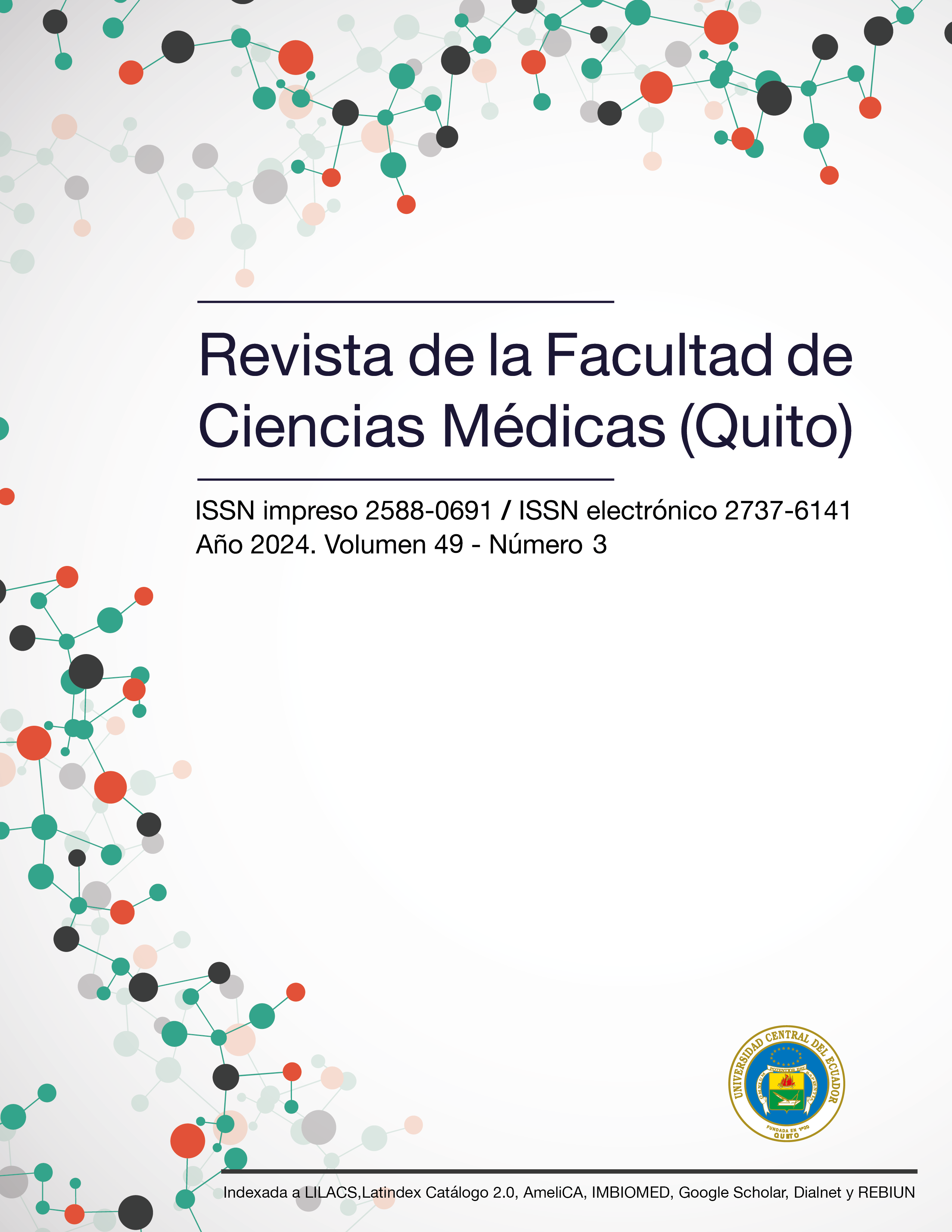Self-efficacy of condom use and Sexual Assertiveness to Prevent HIV/AIDS in Indigenous Youth
DOI:
https://doi.org/10.29166/rfcmq.v49i3.6786Keywords:
Self-efficacy, indigenous people, condoms, assertiveness, sexuality, sexually transmitted diseasesAbstract
Introduction: in 2020, 37.7 million people were living with HIV worldwide, with 1.5 million new infections and 680,000 related deaths. Young people, who account for 27% of new infections, face a high risk. Lack of education and early initiation of sexual life are factors that increase risk behaviors, while self-efficacy and sexual assertiveness are key elements for preventing infections.
Objective: to determine the relationship between self-efficacy of condom use and sexual assertiveness for the prevention of HIV/AIDS in young people from an indigenous community who have an active sexual life.
Material and methods: descriptive correlational study with a final sample of 219 participants; 133 were men and 86 women. Descriptive and inferential statistics were used.
Results and discussion: an average age of 17.53 years was obtained, high school education, of which 73.1% only studies and 26.9% studies and works, 41.1% report having parents who speak an indigenous language. The average age at the beginning of active sexual life (IVSA) was 15.89 years, as well as an average number of sexual partners to date of 1.9, 70.3% reported currently having a partner and 30.1% stated they had been having a partner for more than six months. with your current partner.
Conclusion: it is concluded that the relationship between condom use self-efficacy and sexual assertiveness (rs=0.89) has a positive relationship, and the beginning of an active sexual life is increasingly at younger ages.
Downloads
Metrics
References
Programa Conjunto de las Naciones Unidas sobre el VIH/sida (ONUSIDA). Hoja informativa. Últimas estadísticas sobre el estado de la epidemia de sida [Internet]. 2021[cited 2024 Sep 25]. Available from: https://www.unaids.org/es/resources/fact-sheet
Organización Mundial de la Salud (OMS). Infecciones de Transmisión Sexual. OMS.Org[Internet] 2021. [cited 2024 Sep 25]. Available from: https://www.oms.org
Instituto Nacional de Estadística y Geografía (INEGI) [Internet].2021[cited 2024 Sep 25]. Available from: https://www.inegi.org.mx
Figueroa L, Figueroa L, García L, Soto D. Abordaje teórico en el estudio de las conductas sexuales de riesgo en la adolescencia. 2019 Oct 9;23(6):954–68.
Losa-Castillo RI, González-Losa MDR. Conductas sexuales en adolescentes en una escuela secundaria en Mérida, Yucatán, México. Revista Biomédica. 2018 Sep 14;29(3).
López-Rosales F, Moral-de la Rubia J. Validación de una escala de autoeficacia para la prevención del SIDA en adolescentes. Salud Pública de México [Internet] 2001 [cited 2024 Jul 19];43(5):421–32. Available from: https://www.scielo.org.mx/scielo.php?script=sci_arttext&pid=S0036-36342001000500006
Morokoff PJ, Quina K, Harlow LL, Whitmire L, Grimley DM, Gibson PR, et al. Sexual Assertiveness Scale (SAS) for women: Development and validation. Journal of Personality and Social Psychology [Internet]1997[cited 2024 Jul 19];73(4):790–804. Available from: http://www.psychwiki.com/dms/other/labgroup/Measufsdfsdbger345resWeek1/Marliyn/Morokoff1997.pdf
Santos Iglesias P, Sierra Freire JC. El papel de la asertividad sexual en la sexualidad humana: una revisión sistemática. International journal of clinical and health psychology [Internet]. 2010 [cited 2024 Jul 19];10(3):553–77. Available from: https://dialnet.unirioja.es/servlet/articulo?codigo=3330194
Pavía-Ruz N, Góngora-Biachi R, Vera-Gamboa L, Moguel-Rodríguez W, González-Martínez P. Conocimientos, actitudes y percepción de riesgo en referencia al VIH/SIDA en población rural de Yucatán, México. Revista Biomédica [Internet]. 2012 [2024 Jul 19];23(2):53–60. Available from: https://www.medigraphic.com/cgi-bin/new/resumen.cgi?IDARTICULO=36556
Reartes DL. La comunidad y la ciudad como referentes en la construcción social de riesgos frente al VIH-Sida entre jóvenes estudiantes hablantes de lenguas indígenas de los Altos de Chiapas. Desacatos [Internet]. 2011 [cited2024 Jul 19];(35):59–74. Available from: https://www.scielo.org.mx/scielo.php?script=sci_arttext&pid=S1607-050X2011000100005
Reartes DL. Trayectorias sexuales y reproductivas de jóvenes migrantes indígenas de Chiapas, México / Sexual and reproductive transitions in indigenous migrant youths from Chiapas, México. (En)clave Comahue Revista Patagónica de Estudios Sociales [Internet]. 2016 [cited 2024 Jul 19];(21):43–70. Available from: https://revele.uncoma.edu.ar/index.php/revistadelafacultad/article/view/1316
Terán-Hernández M, Díaz-Barriga F, Cubillas-Tejeda AC. Diagnóstico de salud y percepción de riesgos, elementos clave para una propuesta de intervención en comunidades indígenas en México. Revista Panamericana de Salud Pública [Internet]. 2016 [cited 2024 Jul 19];39:106–14. Available from: https://www.scielosp.org/article/rpsp/2016.v39n2/106-114/
Gray JR, Grove SK. Burns and grove’s the practice of nursing research: Appraisal, synthesis, and generation of evidence. 9th ed. Elsevier; 2021.
Uribe JI, Bahamón MJ, Ruíz LR, Trejos AM, Alarcón-Vásquez Y. Percepción de autoeficacia, asertividad sexual y uso del condón en jóvenes colombianos. Acta Colombiana de Psicología. 2017;20(1):203–20.
Kalolo A, Kibusi S. The influence of perceived behavior control, attitude and empowerment on reported condom use and intention to use condoms among adolescents in rural Tanzania. Reproductive Health [Internet]. 2015[cited 2024 Sep 5]:12.105. Available from: https://doi.org/10.1186/s12978-015-0097-5
Chambers RS, Rosenstock S, Lee A, Goklish N, Larzelere F, Tingey L. Exploring the Role of Sex and Sexual Experience in Predicting American Indian Adolescent Condom Use Intention Using Protection Motivation Theory. Frontiers in Public Health [Internet]. 2018[cited 2024 Sep 5].12;6. https://doi.org/10.3389/fpubh.2018.00318. PMID: 30483489; PMCID: PMC6240587.
Downloads
Published
How to Cite
Issue
Section
License
Copyright (c) 2024 María Aracely Márquez Vega

This work is licensed under a Creative Commons Attribution-NonCommercial-NoDerivatives 4.0 International License.









